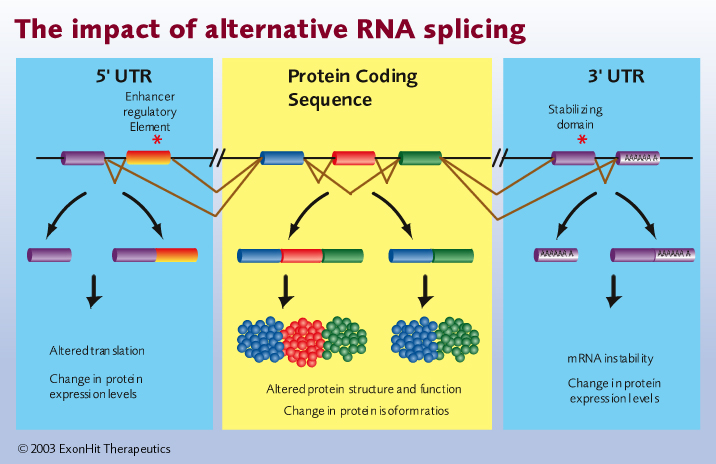Alternative RNA Splicing
The human genome sequencing project (Venter et al., 2001) estimated the number of human genes to be between 30,000-40,000, which is much less than the previous estimates based on analysis of expressed sequence tags (ESTs, 100,000 to 150,000 genes). This increased diversity at the mRNA level can, in part, be accounted for by alternative RNA splicing. Understanding this diversity will be critical for future drug discovery and diagnostics efforts.
RNA splicing is an essential, precisely regulated post-transcriptional process t hat occurs prior to mRNA translation. A gene is first transcribed into a pre-messenger RNA (pre-mRNA), which is a copy of the genomic DNA containing intronic regions destined to be removed during pre-mRNA processing (RNA splicing), as well as exonic sequences that are retained within the mature mRNA. During RNA splicing, exons can either be retained in the mature message or targeted for removal in different combinations to create a diverse array of mRNAs from a single pre-mRNA, a process referred to as alternative RNA splicing (Lopez, 1998).
RNA splicing is an essential, precisely regulated post-transcriptional process t hat occurs prior to mRNA translation. A gene is first transcribed into a pre-messenger RNA (pre-mRNA), which is a copy of the genomic DNA containing intronic regions destined to be removed during pre-mRNA processing (RNA splicing), as well as exonic sequences that are retained within the mature mRNA. During RNA splicing, exons can either be retained in the mature message or targeted for removal in different combinations to create a diverse array of mRNAs from a single pre-mRNA, a process referred to as alternative RNA splicing (Lopez, 1998).
Click on the figure to see the animation
Alternative splice events that affect the protein coding region of the mRNA will give rise to proteins which differ in their sequence and therefore in their activities. Alternative splicing within the non-coding regions of the RNA can result in changes in regulatory elements such as translation enhancers or RNA stability domains, which may have a dramatic effect on the level of protein expression (see the figure below). It is therefore important that the regulation of RNA splicing is at a comparable level to that observed for RNA transcription or translation. This is the case as RNA splicing occurs within a tightly regulated, multi-component molecular, machines called spliceosomes, which is under the control of intra- and extra-cellular signalling pathways.
The accuracy of RNA splicing is also monitored by RNA proof reading mechanisms that are able to target incorrectly spliced mRNA for destruction or can correct the error.
Genome-wide methods have recently been developed for the identification of alternative splice transcripts to support drug discovery and diagnostics efforts. These methods should allow isoform specific drug discovery and improved drug efficacy, together with the isolation of diagnostic signatures with increased specificity.
Bibliography
Genome-wide methods have recently been developed for the identification of alternative splice transcripts to support drug discovery and diagnostics efforts. These methods should allow isoform specific drug discovery and improved drug efficacy, together with the isolation of diagnostic signatures with increased specificity.
Bibliography
- Venter, J.C. et al. (2001) The sequence of the human genome. Science 291, 1304-1351.
- Lopez, A.J. (1998) Alternative splicing of pre-mRNA: developmental consequences and mechanisms of regulation. Annu Rev Genet 32, 279-305
reprint from www.exonhit.com
























 6278
6278

 被折叠的 条评论
为什么被折叠?
被折叠的 条评论
为什么被折叠?








